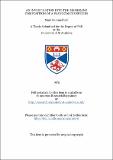Files in this item
An investigation into the membrane composition of a planococcus species
Item metadata
| dc.contributor.advisor | Thirkell, David | |
| dc.contributor.author | Summerfield, Mark | |
| dc.coverage.spatial | 172 p. | en_US |
| dc.date.accessioned | 2018-06-12T15:44:21Z | |
| dc.date.available | 2018-06-12T15:44:21Z | |
| dc.date.issued | 1975 | |
| dc.identifier.uri | https://hdl.handle.net/10023/13976 | |
| dc.description.abstract | Planococcus C.C.M. 316, a gram-positive facultative marine halophile, was studied with respect to growth and membrane composition of cells grown in media containing 0.5%, 3% and 10% sea salt. Membranes were prepared from cells grown in the three sea salt concentrations and analysed to determine any changes which may have been caused by the increasing concentrations of salt in the growth media. The three membrane preparations were found to have similar compositions to those reported for other gram-positive cocci. Cells grown in the 3% sea salt concentration contained membranes with a higher protein:lipid ratio and RNA content than the membranes from cells grown in the 0.5% and 10% concentrations. Amino acid analysis of the membrane proteins showed that the composition remained virtually unchanged in the three membrane preparations. The ratio of acidic: basic amino acid residues was nearer to the figures reported for non-halophiles than for those of the extreme halophiles. Examination of the lipids showed that phospholipids predominated to the extent of about 70% of the total lipids. Cardiolipin and lysocardiolipin were the major phospholipids, with phosphatidyl ethanolamine, phosphatidyl glycerol and phosphatidyl serine present as minor components. Glyco-lipids were found to decrease with increasing sea salt concentration in the medium, and in all three membrane preparations constituted only a very small proportion of the total lipids. Neutral lipids contained long chain alcohols, mono-, di- and tri-glycerides, as well as relatively large amounts of the isoprenoid compound squalene. The major fatty acid associated with the lipids was a branched saturated C15 acid which constituted 50 - 7% of the total fatty acids in most fractions. Although increasing salt in the medium produced changes within the proteins and lipids in the membranes, these changes were not such that they could be interpreted as an increase in the halophilic nature of the membrane. The carotenoids were shown to be derived from beta carotene and to consist mainly of 3'hydroxy 4' oxo compounds, although the extent of polar substitutions was dependent on both culture age and the concentration of salt in the medium. | en_US |
| dc.language.iso | en | en_US |
| dc.publisher | University of St Andrews | |
| dc.subject.lcc | QH601.S8 | en |
| dc.subject.lcsh | Membranes (Biology) | en |
| dc.title | An investigation into the membrane composition of a planococcus species | en_US |
| dc.type | Thesis | en_US |
| dc.type.qualificationlevel | Doctoral | en_US |
| dc.type.qualificationname | PhD Doctor of Philosophy | en_US |
| dc.publisher.institution | The University of St Andrews | en_US |
This item appears in the following Collection(s)
Items in the St Andrews Research Repository are protected by copyright, with all rights reserved, unless otherwise indicated.

